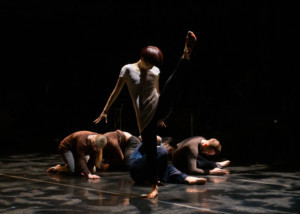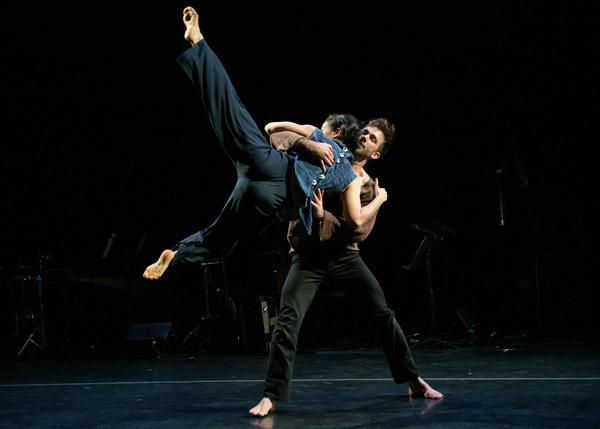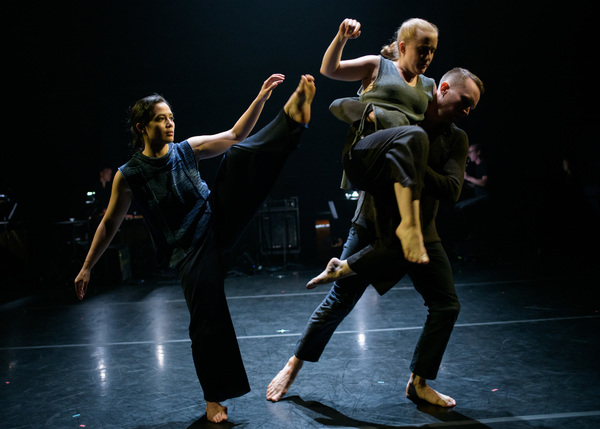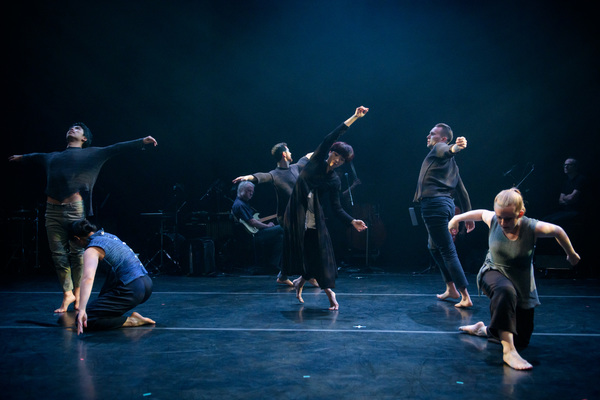Review: DOUG VARONE AND DANCERS IN THE SHELTER OF THE FOLD / EPILOGUE is Transcendent and Transfixing

Doug Varone and Dancers in the shelter of the fold / epilogue is a transcendent and transfixing inquiry into public and private relationships to faith through seven vignettes that intermingled fluidly at BAM's Fisher from June 5-8th. The thirteen bodies in nearly continuous motion -- choreographed by Varone -- were so mesmerizing that the captivated viewers were on the edge of their seats during the entire performance. The evening was as sonically spellbinding as it was visually enchanting thanks to the complex, varied and at times otherworldly or ethereal sounds provided a diverse array of multiple compositions played by Bang on a Can All-Stars with PUBLIQuartet and Lesley Flanigan.
Expressions of religion, belief and spirituality are not new to dance. Such physical explorations of divinity that are centuries old can still be seen today, such as the Sufi whirling dervishes and the Hindu Kathakali performances -- whose roots in the temple dances from India are traceable to the first century of the Common Era (C.E.), but are likely even older. In more recent times, Ruth Saint Denis, Isadora Duncan and Martha Graham all integrated aspects of myths (pagan and otherwise), divine mysteries and even religious themes into their ecstatic dances. It is probable that dance and music went hand in hand with early spiritual practices and investigations of faith and devotion, for both have been used together and separately as a means of tapping into a power beyond verbalization and as methods of communicating with the divine.
The work presented by Doug Varone and Dancers was more human and because of that if felt both grounded and fragile. These were not expressions of supreme beings but of people trying sincerely to grasp -- sometimes desperately, other times with great clarity -- the meaning of it all and their relationships as individuals, pairs or groups with a higher power beyond themselves. The opening piece entitled "in the shelter of the fold" (New York City premiere) set the tone with lighting (exquisitely designed by David Grill) pouring in from the sides and above as if from the windows of a cathedral on a solemn morning. This led into "horizon," the second movement and a group number with music by Lesley Flanigan called "Sleepy" that possessed a distant, breathy droning quality. The six dancers clustered together in shapes and moved as if one organism or at times a chain reaction but always fluid and hypnotic as the waves of an ocean -- separate but part of a whole. That was perhaps the most pervasive physical and visual theme of the performance -- individuals coming together and informing one another's actions -- be they a pair, trio or group.
Several of the most dynamic dances happened between those juxtapositions. The piece "folded" with music "Believing" by Julia Wolfe that featured a male duo, Hollis Bartlett and Bradley Beaks, had the two strikingly similar men act as alternative mirrors or support systems to each other in a hyper-athletic, almost violent, relentless interaction. Their dynamic domino-effect movements were enhanced by the rapid intensity of the percussion, clarinet and vocals -- a hauntingly beautiful reminder of the need for a partner, be they physical or spiritual. In contrast, the duet called "field" between Doug Varone himself and Courtney Barth with the song "Light Is Calling" by Michael Gordon, was a much more subdued, gentle and tender -- though no less meaningful -- encounter. It had the sense of a couple later in their years, a father/daughter relationship or perhaps the inexhaustible love and guidance of an angelic being.
The trio (Jake Bone, Whitney Dufrene and Aya Wilson) who performed the movement entitled "shelter" with David Lang's song "Stick Figure" to accompany, enacted a complicated ballet of codependency with the focus and attention being constantly shifted between the three, one always a bit out of the loop -- like a child caught between two parents or simply people feeling torn between worlds and situations. The piece "mass" with the rich soundscape of "La Citadelle" by Raz Mesinai was the largest group number with all thirteen astounding dancers -- who can only be fairly described in terms of a collective because they genuinely breathe as one organism. It was, in ways, controlled chaos with followers and leaders. The word "mass" served a dual meaning in the way of a Catholic Mass -- with a group of devout believers worshiping collectively -- and the masses, a large collection of people gathering or thrust together for a common cause or reason. This dance was fraught with furious, stressed movements and dramatic leaps and falls. The music enhanced this anxiety and created a feeling of hysteria. Sometimes there was a sense of following a specific leader at other times only drama, intensity and chaos. It was a potent and powerful examination as a whole but the one specific moment that remained imprinted was when they all fell to the ground and crawled like animals -- evoking perhaps the sheep that only follow, or humanity's primal roots? At times the barbarism and zealousness in the sounds and gestures was evocative of a crusade, colonization or holy war -- which the song's title suits, for a citadel is a high fortress or stronghold, often used for military purposes.
The performance that followed was the most starkly contrasted -- a solo piece featuring Hsiao-Juo Tang alone onstage in the calm after stormy action that preceded. All of the dancers were beautifully expressive and possessed a capacity to portray depth and emotion through their bodies with excellent technique, but the Taiwanese-born Tang was particularly captivating to watch in the group vignettes and even more so in her solo. The piece dealt with the aftermath of such a frenetic whirlwind of passions and tensions. Though her body and facial expressions she conveyed longing, loneliness and inner torment with heartbreaking grace and exquisite elegance. The melancholic piano in the song "Hope" by Kevin Keller, provided the mood that propelled her movements like a leaf being blown in the wind or adrift at sea -- lost and seeking shelter, comfort and peace. The group enters in silence and at first passes her by (as if at a crosswalk on a busy city street), then they prostrated and crawled towards her. A dynamic shift in awareness has occurred. This begins the final movement and second New York City premiere to bookend the evening -- "epilogue" with lighting by David Ferri and the music "Hedra" created and performed by Leslie Flanigan. It had a sense of stillness more than the other group numbers and also a feeling of reverence, a kind of return to the fold or waves crashing back into the ocean and becoming part of that whole again. It ends with the group kneeling as if in prayer and with Tang exiting forward while shaking her head from side to side (a gesture repeated at other moments in the performance).
However, there was not a notion of completeness, finality or clear conclusion. Rather the journey, like most spiritual inquiries, only left one with more questions and considerations. But after bows, the rapt audience -- who were fully engaged at all times -- reclined back into their seats for a pause before departing and were able to (much like the dancers) exhale for the first time during the meditative and compelling production to reflect on what had just transpired. While no one may have left the experience with any more clarity or answers to the great mysteries of life, faith and beliefs, it would be nearly impossible not to walk away without feeling inspired, uplifted and moved on a deeper spiritual level.

Doug Varone Dancers Jake Bone and Aya Wilson in "shelter" from "in the shelter of the fold / epilogue" at BAM Fisher. Photo by Ian Douglas.

Doug Varone Dancers Aya Wilson, Jake Bone and Whitney Dufrene in "shelter" from "in the shelter of the fold / epilogue" at BAM Fisher. Photo by Ian Douglas.

Doug Varone Dancers (Hsiao-Juo Tang, center) in "epilogue" from "in the shelter of the fold / epilogue" at BAM Fisher. Photo by Ian Douglas.
Reader Reviews
Videos


